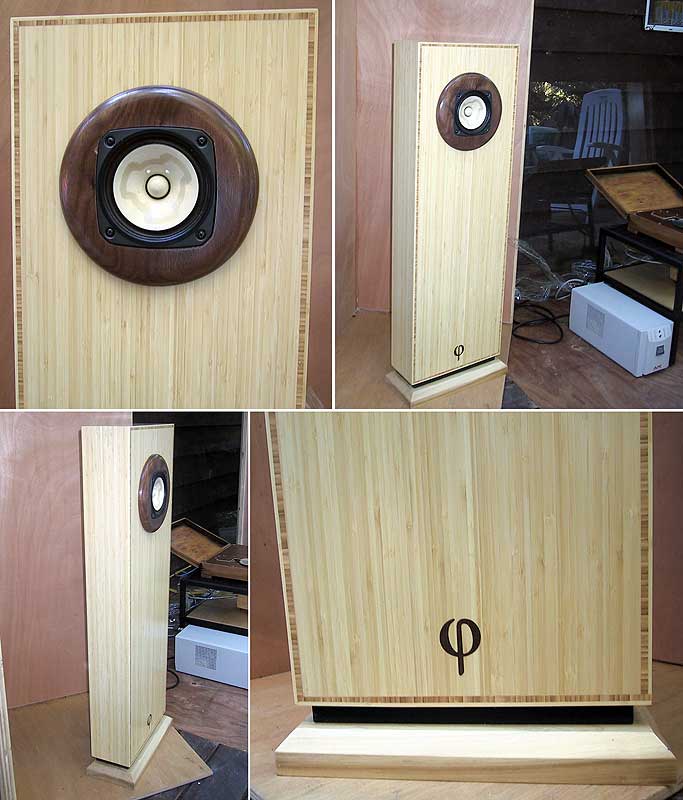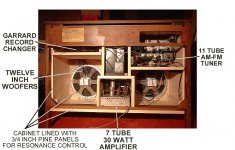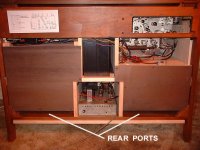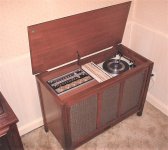Regarding cabinet design...
Back in 2009 when I rebuilt and redesigned my 1963 RCA Victor stereo console, I literally tore it down to the outer shell.
Being in pristine shape otherwise (an old lady once owned it, honestly) the side walls were 1/4 inch plywood, laminated with walnut, and it had an open bottom.
Now that construction naturally resonated with a bass boom, not my opinion of High Fidelity.
But that's what sold consoles like that - people were impressed by all that boom from a flexing cabinet.
No, not me.
So once I tore out the guts, I proceded to line the whole inner walls with 3/4 inch furniture grade pine - making the sides 1 inch thick.
The front, along with the interior and bottom, was done in the same pine - braced, interlocked, glued and screwed.
I chose an asymmetrical design for the speaker chambers, one slightly larger than the other.
Why, you ask?
To reduce the chances of both woofers peaking at the same frequency, which would happen if they were in identical chambers.
That results in "one note bass" issues - again, not "hifi".
I wanted to hear what the speakers were offering, not the cabinet.
The interior sections were also part of eliminating resonance - the tube amplifier in its own chamber was shielded from woofer vibrations, as is the tuner/preamp, and the amp chamber was designed with enhanced convention cooling, drawing cool air from the cabinet bottom through a screen, and hot air flowing out the back. (no noisy fan needed)
Also, the record storage area directly above it is isolated and insulated from heat to eliminate warped records - and it works perfectly, the floor of the storage area stays room temperature after hours of use.
Even the Garrard record changer is in its own sealed section to limit/prevent feedback issues at high volume.
After all this, and the added weight of the components, this thing weighs about 200 pounds I suppose - a two-man job to carry.
In the photo, please note that those speakers were only temporary, being the original RCA speakers - the current 12 inch woofers, midrange, and tweeters are modern replacements, hand-picked for the best response from this console, along with polyfill and fiberglass stuffing, and added rear ports.
My picky audiophile friends are impressed by the resulting sound quality, as am I.
Introducing the RCA Victor Custom Concertmaster Deluxe.......
Back in 2009 when I rebuilt and redesigned my 1963 RCA Victor stereo console, I literally tore it down to the outer shell.
Being in pristine shape otherwise (an old lady once owned it, honestly) the side walls were 1/4 inch plywood, laminated with walnut, and it had an open bottom.
Now that construction naturally resonated with a bass boom, not my opinion of High Fidelity.
But that's what sold consoles like that - people were impressed by all that boom from a flexing cabinet.
No, not me.
So once I tore out the guts, I proceded to line the whole inner walls with 3/4 inch furniture grade pine - making the sides 1 inch thick.
The front, along with the interior and bottom, was done in the same pine - braced, interlocked, glued and screwed.
I chose an asymmetrical design for the speaker chambers, one slightly larger than the other.
Why, you ask?
To reduce the chances of both woofers peaking at the same frequency, which would happen if they were in identical chambers.
That results in "one note bass" issues - again, not "hifi".
I wanted to hear what the speakers were offering, not the cabinet.
The interior sections were also part of eliminating resonance - the tube amplifier in its own chamber was shielded from woofer vibrations, as is the tuner/preamp, and the amp chamber was designed with enhanced convention cooling, drawing cool air from the cabinet bottom through a screen, and hot air flowing out the back. (no noisy fan needed)
Also, the record storage area directly above it is isolated and insulated from heat to eliminate warped records - and it works perfectly, the floor of the storage area stays room temperature after hours of use.
Even the Garrard record changer is in its own sealed section to limit/prevent feedback issues at high volume.
After all this, and the added weight of the components, this thing weighs about 200 pounds I suppose - a two-man job to carry.
In the photo, please note that those speakers were only temporary, being the original RCA speakers - the current 12 inch woofers, midrange, and tweeters are modern replacements, hand-picked for the best response from this console, along with polyfill and fiberglass stuffing, and added rear ports.
My picky audiophile friends are impressed by the resulting sound quality, as am I.
Introducing the RCA Victor Custom Concertmaster Deluxe.......
Attachments
...If one reduces box size, the wavelength of stuff that builds up inside the box goes up in frequency and the damping inside has a better chance to quell it...
dave
...and the less room one has to accommodate the damping material... 😉
... Wavelengths shorter than the box reflect off the walls and strike the back of the speaker cone...
And they don't just strike it - they go straight through, as the cone is pretty much transparent (especially compared to the cabinet walls)!
The going back through the cone ... : I suspect this is one of the main reason people like open baffle and not for the radiation patern of open baffle. And also the reason stiff cone have more details whatever the break ups one has to deal with ... certainly also a good reason to use sandwich cones not only for the self damping of the cone itself but also for this going back wave.... (though ESL ????)
With conventional cabinet the Harwood full stuffing seems to be a good compromise if one is able to rule the Vab which number increases. I sometimes asked myself with some design if indeed a resistive trap, known as Varioventjust behind the main cap could be a good trade off to theorically fight this going backs on the main cone... But thinking it twice, no way, the box is presurized and as said the cone is less stiff than the walls, this last singing at their resonance frequency...
Finally the choice of this reasonance frequency area and level is the only "easy" choice a designer can choose...
Sometimes I asked myself if the woofer on a standalone baflfe for it, with a material that has a stiff & damping behavior that seems to be opposit things, on a heavily machine ruber damping frame (1cm thickness) putt itself on a wood frame -as are made some speakers with removable screwed front and rear baffle à la Harbeth is not the easisest choice for diy monkey coffins ???
There is no doubt that the loudspeakers walls become themselves drivers at resonance frequency and that the sport is to reduce the spl of this resonance if I understood correctly what acheive best enthusiasts and professionals here.
Dr Earl Geddes material choice (Remschape something) is hardly difficult to source for enthusiast... with bambou ply for kitchen desks, I asked myself why not for the woofer a cheap composite like low density polyethylene, or wood osb panel which chaotic structure of glued plys certainly distribute the frequencies reasonance at several frequencies so intensities... not much beautifull that this last but can be covered with industrial dense wool (white or grey).
this front panel for the woofer should be the closest size to the driver to reduce its emiting surface. Of course there is also the choice of a thick rubber between the woofer and the baffle but one has to find ruber insert on the baffle for the screws to let the driver dance : I'm not sure due to the length of wave length of a woofer than micro shaking of its body is problematic... Anyhow there always be resonant frequencies somewhere due to the meeting of the resonance frequency of the cabinets walls outsides with the back wave of the cone at those frequencies ...
With conventional cabinet the Harwood full stuffing seems to be a good compromise if one is able to rule the Vab which number increases. I sometimes asked myself with some design if indeed a resistive trap, known as Varioventjust behind the main cap could be a good trade off to theorically fight this going backs on the main cone... But thinking it twice, no way, the box is presurized and as said the cone is less stiff than the walls, this last singing at their resonance frequency...
Finally the choice of this reasonance frequency area and level is the only "easy" choice a designer can choose...
Sometimes I asked myself if the woofer on a standalone baflfe for it, with a material that has a stiff & damping behavior that seems to be opposit things, on a heavily machine ruber damping frame (1cm thickness) putt itself on a wood frame -as are made some speakers with removable screwed front and rear baffle à la Harbeth is not the easisest choice for diy monkey coffins ???
There is no doubt that the loudspeakers walls become themselves drivers at resonance frequency and that the sport is to reduce the spl of this resonance if I understood correctly what acheive best enthusiasts and professionals here.
Dr Earl Geddes material choice (Remschape something) is hardly difficult to source for enthusiast... with bambou ply for kitchen desks, I asked myself why not for the woofer a cheap composite like low density polyethylene, or wood osb panel which chaotic structure of glued plys certainly distribute the frequencies reasonance at several frequencies so intensities... not much beautifull that this last but can be covered with industrial dense wool (white or grey).
this front panel for the woofer should be the closest size to the driver to reduce its emiting surface. Of course there is also the choice of a thick rubber between the woofer and the baffle but one has to find ruber insert on the baffle for the screws to let the driver dance : I'm not sure due to the length of wave length of a woofer than micro shaking of its body is problematic... Anyhow there always be resonant frequencies somewhere due to the meeting of the resonance frequency of the cabinets walls outsides with the back wave of the cone at those frequencies ...
Attachments
Last edited:
...and the less room one has to accommodate the damping material... 😉
Only applicable when you talk sbout sealed, aperiodic TLs, or other speakers that have volume fill damping.
dave
The going back through the cone ... : I suspect this is one of the main reason people like open baffle and not for the radiation patern of open baffle.
It is certainly one of the things an OB does. Instead the sound comes around the sides of the baffle.
Also, i think that one of the prime reasons people like OBs is because there are so many really poorly built boxes to compare them to.
dave
...and the less room one has to accommodate the damping material... 😉
And they don't just strike it - they go straight through, as the cone is pretty much transparent (especially compared to the cabinet walls)!
If you make the box shallow enough there won't be much energy that high making it even easier to absorb.
Alas that does not work (from experience). If the wall behind the driver is too close you hear it.
dave
dave
Also, i think that one of the prime reasons people like OBs is because there are so many really poorly built boxes to compare them to.
Maybe. The ones I've asked mostly say they find the reflections from the back gives an ambience they prefer to pin point imagery.
Alas that does not work (from experience). If the wall behind the driver is too close you hear it.
What do you call too close?
It is certainly one of the things an OB does. Instead the sound comes around the sides of the baffle.
Also, i think that one of the prime reasons people like OBs is because there are so many really poorly built boxes to compare them to.
dave
That's what I believe, more from hearings than self experience with construction 😱.
Maybe.
Not maybe. For sure. Even 19mm can make a significant difference.

The supraBaffle that thick made all the difference in the world. And i might do the same on my Hawking Memorial Monoliths (Eikonas going up for sale, Alpair 11ms going in). For the same reason (Chris is convinced the shallow enclosurw contributed to the A11ms outperforming the Eikona)
dave
What do you call too close?
4” seems to be not quite enuff. Also found that sides in too narrow enclosures cause the same issue althou they can be much closer than a back wall.
dave
How many people who like OB said it was because of poor box design?Not maybe. For sure.
Any measurements to show?For the same reason (Chris is convinced the shallow enclosurw contributed to the A11ms outperforming the Eikona)
4” seems to be not quite enuff. Also found that sides in too narrow enclosures cause the same issue althou they can be much closer than a back wall.
What issue are you referring to?
More than just me. But i am not a fan of OB. Everyone i have heard has the same time delay issues, and BTB one of the “boxiest" speakers i have ever heard was an OB.
There are a zillion compromises in any loudspeaker and OB has characteristics that mean they are not a compromise i can live with.
dave
There are a zillion compromises in any loudspeaker and OB has characteristics that mean they are not a compromise i can live with.
dave
Any measurements to show?
Just try to find that issue in the measures. I do not often show measures, many take far to much stock in them, and it is so easy to misinterpret or even get significantly different results with the same driver.
dave
I know "boxy" sound is something people refer to, what positive things have you heard people say about OB?
Just try to find that issue in the measures.
A difference comparison could be done, it would be interesting to see the effects of a shallow enclosure.
C'mon Scott, Dave's a cabinet designer. He solves the problems cabinets impart on a driver making sound. That's his forte. If he thought there was something positive enough about an OB, he'd offer such designs in his build plan sets.
OB solves some problems at the expense of others. Not sure what the "time delay" effect is that Dave hears and cant live with, which his cabinets dont exhibit - but impart other effects he has to fiddle with, working for years to get things just right.
I think my OBs image fine. One of the compromises is even one butt over on the sofa, that doesnt work anymore. I'm fine with it, given the other characteristics I hear and like. Others would toss the whole thing based on that one aspect - regardless of what it seems to do "well" otherwise.
I have to believe speaker building is a never ending search for a design that optimizes all aspects of most effectively coupling a driver to the air. I think OB is a very easy way to knock a bunch of the pins down in one shot - leaving of course several issues still standing. With more effort you can knock out another or two, but there'll always be something that a lot more effort - as in another entirely different approach - would be needed.
Which of course pops back into issue some of the attributes OB easily solved and need to be cleverly dealt with - or lived with.
OB solves some problems at the expense of others. Not sure what the "time delay" effect is that Dave hears and cant live with, which his cabinets dont exhibit - but impart other effects he has to fiddle with, working for years to get things just right.
I think my OBs image fine. One of the compromises is even one butt over on the sofa, that doesnt work anymore. I'm fine with it, given the other characteristics I hear and like. Others would toss the whole thing based on that one aspect - regardless of what it seems to do "well" otherwise.
I have to believe speaker building is a never ending search for a design that optimizes all aspects of most effectively coupling a driver to the air. I think OB is a very easy way to knock a bunch of the pins down in one shot - leaving of course several issues still standing. With more effort you can knock out another or two, but there'll always be something that a lot more effort - as in another entirely different approach - would be needed.
Which of course pops back into issue some of the attributes OB easily solved and need to be cleverly dealt with - or lived with.
- Home
- Loudspeakers
- Multi-Way
- The best cabinet material !!!!



